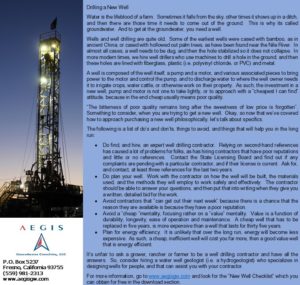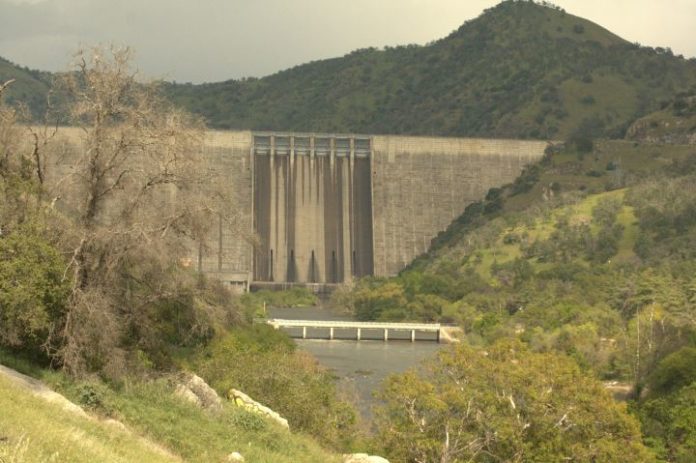 The North Fork Kings Groundwater Sustainability Area held its board of directors meeting at the Riverdale Memorial Hall in Riverdale of all places, on Wednesday, September 26, 2018. Chairman Mark McKean called the meeting or order at 5:30 pm on the nose. He ran through the first items faster than I can type this sentence without spelling errors. Charlotte Gallock KRCD gave the staff report saying DWR has a water quality survey circulating. Krystal Tufenkjian gave the rural community advisory committee report saying so many folks were new to SGMA they had a SGMA 101 session. A couple of non-governmental
The North Fork Kings Groundwater Sustainability Area held its board of directors meeting at the Riverdale Memorial Hall in Riverdale of all places, on Wednesday, September 26, 2018. Chairman Mark McKean called the meeting or order at 5:30 pm on the nose. He ran through the first items faster than I can type this sentence without spelling errors. Charlotte Gallock KRCD gave the staff report saying DWR has a water quality survey circulating. Krystal Tufenkjian gave the rural community advisory committee report saying so many folks were new to SGMA they had a SGMA 101 session. A couple of non-governmental  organizations, the Community Water Center and Self Help Enterprises are helping with the public outreach. There should be a tour coming up to show folks how the water system works.
organizations, the Community Water Center and Self Help Enterprises are helping with the public outreach. There should be a tour coming up to show folks how the water system works.
McKean next informed us all the Kings Sub Basin has received a $1 million grant for GSP development. This will be split between all seven of the GSAs in the bus station, I mean sub basin. NFKGSA is the lead agency and as such has to approve being the chair of the grant recipients. The board agreed.
Provost & Pritchard’s Keven Johansen gave an overview of the GSP development. He said in four months he expects a public draft of the GSP. He spoke about how to choose the base period to set the standards. The sub basin coordination group of all seven GSAs ended up looking up at two different time spans. They ended up picking 1996-97 through 2010-11 as a representative period to base groundwater pumping. Even with this there were still adjustments due to underestimating surface supply deliveries to the area. The change of groundwater storage between spring of 1997 and spring of 2012 is one clear marker for estimating figures for GSP. There’s a data gap from the south west most portion of the sub basin. This was a lack of information of the earlier years that has been provided for the later time – a best estimate is being used. Johansen gave an example of how overdraft in the Liberty Water District by calculating the depth to groundwater averages. The sub basin is over-drafting 120,000 to 130,000 a/f annually. Each GSA will be assigned a share of this overdraft amount based on the different averages as per the method given as an example of Liberty WD.
Johansen showed the different clay layers with underground flows from east to west. Some of this flow goes past NFKGSA to Westlands Water District. Westlands has reached out to resolve any discrepancies that could cause a problem in determining the water budgets. There are three main subsurface clay layers; from the shallow 50-60 feet A, the deeper C and 500 feet deep E layer.* E is often called the Corcoran Clay layer. Pretty much the space between the layers is a confined aquifer. Most of NFKGSA has all three layers underlying it.
Next Johansen showed how the rate of groundwater decline can give insight to what the minimum threshold will be. The minimum threshold is the absolute lowest the groundwater level can decline.  Anything lower and the undesirable conditions as defined by SGMA could occur and throw the GSA out of compliance. That would open the door for the state to come in and set draconian limits and fees to pumping. A measurable objective – the desired average level will be used as the, well average water level that will prevent the undesirable conditions will be established by the GSA and listed in the GSP. The measurable objective could be 100 feet above the minimum threshold, or 200 feet or 50 feet depending on what the GSA sets. He showed how the data from monitoring wells show the influence on the GSA’s average. For instance; along the southern boarder of the NFKGSA the water level in wells stays pretty shallow and flat – not much variation in depth year by year. Of course, these wells are right along the Kings River. Further north the yearly depths show a definite decline in water levels. Some of the wells are dropping five feet per year.
Anything lower and the undesirable conditions as defined by SGMA could occur and throw the GSA out of compliance. That would open the door for the state to come in and set draconian limits and fees to pumping. A measurable objective – the desired average level will be used as the, well average water level that will prevent the undesirable conditions will be established by the GSA and listed in the GSP. The measurable objective could be 100 feet above the minimum threshold, or 200 feet or 50 feet depending on what the GSA sets. He showed how the data from monitoring wells show the influence on the GSA’s average. For instance; along the southern boarder of the NFKGSA the water level in wells stays pretty shallow and flat – not much variation in depth year by year. Of course, these wells are right along the Kings River. Further north the yearly depths show a definite decline in water levels. Some of the wells are dropping five feet per year.
A member of the audience asked if the sub basin’s underground flow rates is being considered by the east to west gradient. Johansen said that criteria is being taken into the formulations. As an example to the north east lies the Central Kings GSA which is Consolidated ID. CKGSA has little surface deliveries where the boundary meets NFKGSA. There is flow into NFKGSA. The west side of NFKGSA has some subsidence – which he and others believe is caused by pumping in Westlands which pulls water out from under the NFKGSA.
Johansen listed some of the ways the GSA can help keep up the water levels. Eleven possible  projects and programs were listed. This list included flooding fields for recharge, water trading, groundwater banking and others. He said this list isn’t the only possible choices and he welcomes other ideas. He was asked how the overdraft went from 250,000 a/f annual to 130,000 a/f annual. By changing the base line period and accounting for more underground flows into the sub basin. McKean said figuring in the confined portion of the aquifer could move the needle back towards higher overdraft. Johansen also said the NFKGSA’s draft GSP could be viewed this coming January, but the over arching King Sub Basin’s draft GSPs won’t be available until June 2019.
projects and programs were listed. This list included flooding fields for recharge, water trading, groundwater banking and others. He said this list isn’t the only possible choices and he welcomes other ideas. He was asked how the overdraft went from 250,000 a/f annual to 130,000 a/f annual. By changing the base line period and accounting for more underground flows into the sub basin. McKean said figuring in the confined portion of the aquifer could move the needle back towards higher overdraft. Johansen also said the NFKGSA’s draft GSP could be viewed this coming January, but the over arching King Sub Basin’s draft GSPs won’t be available until June 2019.
The next time was the financial report and the fiscal year starts in July for the North Fork Kings GSA. The budget moved slowly but as things ramped up it was consumed as expected by the end of the year. The call for funds in July was answered by all member agencies.
 Tufenkjian gave the outreach update for September 2018. The outreach goals are on track. The public is becoming more and more aware of SGMA through public workshops, mailings, the internet and other means. The GSA is developing a speakers bureau and welcomes invitations to Rotary Clubs, school boards and other community organizations. The information has to be understandable to have any value so not all the outreach material is hydrographs and soil type studies. A website portal is being developed to specifically address GSPs. Good for her. The outreach budget for 2019 is just under $20,000.
Tufenkjian gave the outreach update for September 2018. The outreach goals are on track. The public is becoming more and more aware of SGMA through public workshops, mailings, the internet and other means. The GSA is developing a speakers bureau and welcomes invitations to Rotary Clubs, school boards and other community organizations. The information has to be understandable to have any value so not all the outreach material is hydrographs and soil type studies. A website portal is being developed to specifically address GSPs. Good for her. The outreach budget for 2019 is just under $20,000.
That was that and the next meeting will be in October on Wednesday the 24th. There will be a conflict with Thanksgiving and ACWA in November, so the meeting will be moved to December 5th. Then they’ll meet again in January unless something changes.
DISCLAIMER OF RESPONSIBILITY; Waterwrights.net strives to provide his clients with the most complete, up-to-date, and accurate information available. Nevertheless, Waterwrights.net does not serve as a guarantor of the accuracy or completeness of the information provided, and specifically disclaims any and all responsibility for information that is not accurate, up-to-date, or complete. Waterwrights.net’s clients therefore rely on the accuracy, completeness and timeliness of information from Waterwrights.net entirely at their own risk. The opinions expressed in this report are those of the author and do not represent any advertisers or third parties. *I recall long ago asking what happened to the B and D clay layers but I don’t remember the answer exactly. I think they are there but broken up as lenses.
ALL RIGHTS RESERVED. Copyright 2018 by Don A. Wright
SGMA The Sustainable Groundwater Management Act of 2014 calls for the formation of Groundwater Sustainability Areas within Basins and Sub-basins to develop Groundwater Sustainability Plans.
North Fork Kings GSA: Directors, Division 1 Buddy Mendes County of Fresno, Div.2 Frank Zonneveld Laguna ID, Div. 3 Carol Hall Laton Community Services Dist., Div. 4 Mark McKean Crescent Canal Company, Div. 5 Leonard Acquistapace Riverdale Irrigation Company, Div. 6 Stephen Maddox Liberty Mill Race Company & Div. 7 Tony Campos Liberty WD






























